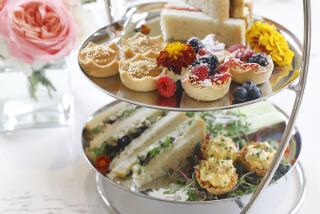Toward More Musical Kitchenware
- Share via
Eight musicians huddled around a single teakettle as it gathered steam on a hot plate. Pressure was building, inside the kettle and out. The water boiled on cue. “Sounds windy,” said one. “Sounds reedy,” said another.
Do all teakettles sound the same note? Not any more. About half of all kettles made today have a whistle to alert the tea maker that water is ready, and many of them are more imaginative in tone than just a simple whistle.
Who better to judge their music than eight of the featured pianists from the recent Piano 2000 Festival at the Kennedy Center in Washington, D.C.? The group, led by Leonard Slatkin, music director of the National Symphony Orchestra, rated an assortment of whistling teakettles earlier this month in the center’s Roof Terrace kitchen.
Each whistle was different. Every whistling teakettle sang its own song.
“I’m getting a C energy,” said Lisa Emenheiser Logan, listening intently, as she put her ear close to a chile-red “Classic” model kettle made by Chantal Cookware.
“It’s layered. Listen. A vibrato. It’s a C and G. The best so far,” said Slatkin assuredly. And then: “This is why we went to Juilliard for four years.”
Next up: the Swissmar “Europro,” a sleek, Belgian-made model, all in stainless steel, a kettle so shiny a guy could shave before it.
Pressure built inside Europro’s dome. First came a modulating eurythmic set of tones. Deep whispers, really. Then the thing let loose with a sustained cacophonous shrill shriek.
“Take it away. Make it stop,” the musicians pleaded in unison.
They hated it. But anyone who has a problem remembering that the kettle is “on” would appreciate a whistle that can be heard from any room in the house.
The teakettle: No other piece of kitchen equipment comes in as many shapes, colors and styles--and tones. There are kettles that take the form of a golf ball, a soccer ball, a strawberry, a kitty. Colors take the name of jewels, such as sapphire, topaz, emerald and ruby.
“The teakettle business is driven by style,” says Vince Kenzierski, senior product manager for World Kitchen, which distributes Via and Revere kettles. “People want a kettle that matches the decor of their kitchen.” Stainless steel is the fastest-growing segment of the teakettle market.
Copco, a division of Wilton Industries, makes kettles in more than 40 styles, ranging from $9.99 to $69.99. “We want to cater to everyone,” says Copco marketing manager Nancy Parks.
In some kitchens, a kettle is a design element for the range top, like a stage prop, the only piece of cookware that is always on view. In many cases the owners don’t even care whether it can boil water, let alone mimic a Chopin sonata.
For others, the teakettle is an essential piece of cookware, an all-important bridge between the tap and tea. Those serious about boiling water want a kettle with a comfortable handle that stays cool to the touch. Their perfect kettle would have a wide lid and be easy to clean. A kettle with a user-friendly, trigger-action or automatic spout that is easy to open and close is a definite plus.
Some whistling teakettles have cumbersome pullout whistles that detach from the spout, an attachment that is easily misplaced or lost. Why manufacture them this way? “It’s a cost consideration. To make the extra parts and attach it to the spout adds to the price,” says Heida Thurwell, founder and president of Chantal Cookware.
Better teakettles have a pleasant whistle tone--not too loud, not too soft--a simple alert that the water is boiling. Chantal’s whistle is harmonic, two-tone. OXO, maker of the Good Grips “Uplift” teakettle that opens automatically when it’s tilted forward, sounds like an approaching train.
A whistle is practical. It’s a safety feature. Without a whistle, a kettle can be easily ruined.
“Once a kettle has boiled dry, say for two or three minutes on a medium flame, the composition of the metal can change. Plastic parts can melt or even ignite. Toxic fumes can even be emitted,” says Tom Ellis, quality-control engineer for New York-based OXO, which tested more than 30 kettles for heat stress.
And a dry kettle is a dead kettle.
“I don’t know how many customers have come in the store and told me the same story,” says Christopher Kilbourn, co-owner of Marketplace Kitchen and Coffee, a kitchenware store in McLean, Va., which carries 17 types of teakettles. “They either go up to make the bed or down to do the laundry. When they go back to the kitchen, the kettle has boiled dry. They throw it out.”
No one heard the whistle, the last sound that kettle would ever make.
More to Read
The biggest entertainment stories
Get our big stories about Hollywood, film, television, music, arts, culture and more right in your inbox as soon as they publish.
You may occasionally receive promotional content from the Los Angeles Times.








